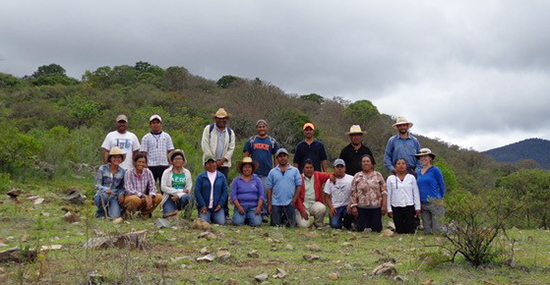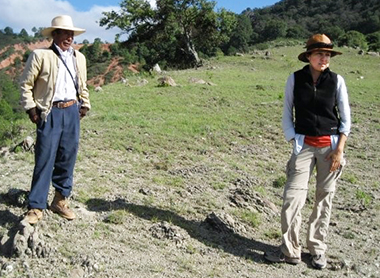Anthropologist Plays Key Role in $1.54M NSF Study on Socio-Environmental Factors in the Mesoamerican Classic Period ‘Collapse’
 |
|
Associate Professor Verónica Pérez Rodríguez, far right in the blue shirt, poses at the site of the ancient Mesoamerican city of Cerro Jazmin with her field crew in 2015. |
ALBANY, N.Y. (Oct. 29, 2020) — One of the great mysteries of anthropology is what brought about the societal transformations and political collapse of the civilizations that developed across Mesoamerica in the Classic Period (250-900 AD). Within this issue is another: What role did climate change and human action play in bringing about the collapse?
An international team of scientists is, for the first time, taking a transdisciplinary approach to tackling this question, supported by a $1.54 million five-year grant from NSF. Among the projects co-principal investigators is UAlbany’s Verónica Pérez Rodríguez, associate professor of Anthropology, who has decades of scholarship on the social and environmental consequences of urbanism.
The study, which includes archaeologists, geoarchaeologists, paleoecologists and bioarchaeologists from the U.S.A, Mexico, Scotland, Canada and France, focuses on two interrelated subsystems: the Río Verde Valley in the lowlands and the Nochixtlán Valley in the temperate highlands, both in the Mixteca region of the Mexican state of Oaxaca.
Pérez Rodríguez will be directing the research in the highlands, including two seasons of archaeological excavations at Cerro Jazmín, an ancient city she has mapped, surveyed and excavated with the support of two previous NSF grants since 2008. “I will also conduct one season of archaeological survey around the Minicúa area, from which my colleagues have collected and will collect more core samples to reconstruct paleoclimatic patterns” she said.
Results from the project will contribute to models of long-term climate change and human impact on the environment with implications for future land use planning and resource management.
 |
|
At Cerro Jazmín, Pérez Rodríguez speaks with a local worker and terrace farmer. |
“It is in these different regions of Oaxaca, the Mixteca Alta highlands and the coastal region of Río Verde where we see a period of societal change and urban depopulation during the late Classic Period. I will also be working with a colleague from the Universidad Autónoma de San Luis Potosí who will be conducting geomorphic surveys in nearby barrancas in the Nochixtlán Valley — also with the purpose of collecting more paleoclimatic data.”
A fascination exists concerning the societal changes — termed a “collapse — that took place across Mesoamerica in the Late Classic Period.” Indigenous Mixtec and Chatino communities in the highlands did not end, however, Pérez Rodríguez pointed out, but adapted and shifted towards different political and social forms that thrived in the Postclassic Period, from 900 to 1521 AD.
“This was when the Mixtec region became a prominent place, where artistic styles and codices originated. After centuries of depopulation, the urban community of Cerro Jazmín grew again and was part of this Postclassic florescence,” she said.
“This project in particular will focus on the areas in Cerro Jazmín where we believe there was a reduced but persistent late Classic and early Postclassic occupation, between 600 and 1300 AD. Our research, focusing on residential areas and agricultural spaces and terraces, seeks to learn how those who stayed behind managed, adapted and eventually thrived in a time where the available data points to changing climatic patterns and profound regional political transformations.”
The NSF project calls for up to 12 graduate students to be involved; Pérez Rodríguez was counting on UAlbany doctoral and master’s students, “as well as a few interested and highly-motivated undergraduates,” to be among them. This year’s pandemic changed that, with one doctoral student having to defer for a year because of being refused an F1-student visa.
“My hope is that there will be an end to the pandemic and that we will be able to begin work in the summer of 2021 as scheduled,” said Pérez Rodríguez. “We would have different field seasons, both in the highlands and in the coast from 2021 to 2024. UAlbany students may be able to participate not only in the research I am directing in the highlands, but also in the work that will take place on the coast, working with Arthur Joyce of the University of Colorado Boulder.”
Results from the project will contribute to models of long-term climate change and human impact on the environment with implications for future land use planning and resource management.
![]() For more news, subscribe to UAlbany's RSS headline feeds
For more news, subscribe to UAlbany's RSS headline feeds
A comprehensive public research university, the University at Albany-SUNY offers more than 120 undergraduate majors and minors and 125 master's, doctoral and graduate certificate programs. UAlbany is a leader among all New York State colleges and universities in such diverse fields as atmospheric and environmental sciences, business, education, public health,health sciences, criminal justice, emergency preparedness, engineering and applied sciences, informatics, public administration, social welfare and sociology, taught by an extensive roster of faculty experts. It also offers expanded academic and research opportunities for students through an affiliation with Albany Law School. With a curriculum enhanced by 600 study-abroad opportunities, UAlbany launches great careers.


